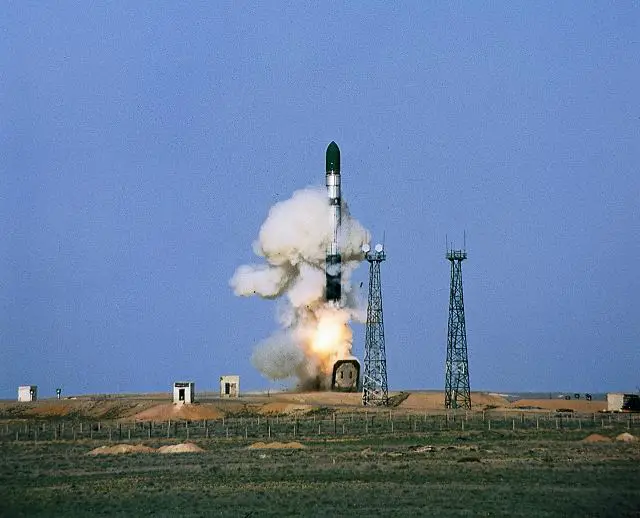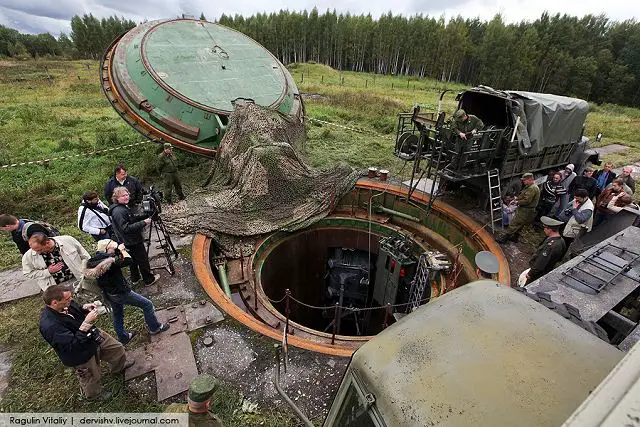New Russian Sarmat and Rubezh ICBM missiles able to defeat all deployed anti-missile systems 12502164
|
|
|||
|
Military Defense Industry Technology - Russian ICBMs
|
|||
|
|
|||
| New Russian Sarmat and Rubezh ICBM missiles able to defeat all deployed anti-missile systems. | |||
|
The launches of two new Russian inter-continental ballistic missiles (ICBM), namely, RS-28 Sarmat and RS-26 Rubezh are scheduled for Spring 2016. Silo-based Sarmat is to replace RS-20A (NATO reporting name: SS-18) ICBM. The world-known RS-12M Topol (SS-27) will be replaced by perspective Rubezh mobile missile system. It was revealed by Russian Ministry of Defense`s (MoD) press department.
|
|||
|
|
|||
 The RS-26 Rubezh mobile ICBM system will replmace the RS-12M Topol (SS-27) The RS-26 Rubezh mobile ICBM system will replmace the RS-12M Topol (SS-27) |
|||
|
|
|||
| RS-26 Rubezh mobile ICBM system (developed by the Moscow Institute of Thermal Technology, Russian acronym: MIT) has passed the appropriate trials. Russian Strategic Missile Forces (SMF) have already started to receive the RS-26 systems. So, the aforementioned launch will be likely a simulated firing. RS-26 is the latest modification of RS-24 Yars mobile ICBM system, which has received new manoeuvring warheads to defeat all types of modern anti-missile defense (AMD) systems. In comparison with RS-24, the ICBM of RS-26 Rubezh has a significantly reduced weight (120 t and <80 t respectively). It is equipped with multiple independent reentry vehicles (MIRV) warhead and anti-AMD package. Three-stage solid-propellant RS-26 ICBM can be armed with four warheads. Every warhead has a capacity of 150-300 kilotons.The RS-26 ICBM has a maximum flight range of 11,000 km and can effectively destroy targets at the 2,000-6,000 km distances. The United States claims, that the missile transgresses the terms of the Intermediate-range Nuclear Forces (INF) treaty The accuracy of the RS-26 ICBM is supposed to be no less, than the RS-24`s one (the Yars circular error does not exceed 150 m). As of March 2015, five test launches of the Rubezh mobile ICBM have been conducted (including four successful). The system`s serial production launch is scheduled for late 2015 - early 2016. The 29th Guards Missile Division (Irkutsk) is supposed to receive the first RS-26s in 2016. A distinctive feature of the new missile is its ability to use hypersonic manoeuvring warheads capable of defeating even perspective AMD systems. In the estimation of military specialists, about 50 SM-3 missile interceptors are required to eliminate one RS-26 ICBM, so the US anti-missile defense system can be easily defeated by the new Russian strategic weapon. |
|||
|
|
|||
 Russian ICBM RS-20A during firing test. Russian ICBM RS-20A during firing test. |
|||
|
|
|||
|
Russian SMF has nothing to equal the Soviet-designed R-36M2 Voevoda (SS-18 Mod.5/Mod.6) ICBM. R-36M2 fourth-generation strategic missile system has two-stage liquid-propellant ampulised 15A18M missile intended for deployment in reinforced OS-type silos. R-36M2 is supposed to be the most effective Russian silo-based strategic weapon. Voevoda has only one significant disadvantage, as the system was designed by Yuzhnoe Design Bureau located at Dnepropetrovsk (Ukraine). Taking into account the current level of the deteriorated Russian-Ukrainian relations, the deployment of the missile developed by a foreign design bureau poses a serious threat to Russian national security. Moreover, the Yuzhny Machine-Building Plant (Yuzhmash, former Yuzhnoe Design Bureau) has stopped the guarantee maintenance of the R-36M2 systems. The Voevoda missiles` service life is also tailing off.
Sarmat heavy ICBM (being developed by the Miass-based Makeyev State Rocket Centre, Russian acronym: GRC) is intended to replace the ageing R-36M2 system. GRC has huge experience of liquid-propellant misssiles development. Sarmat is not a Voevoda modification; it is a new ICBM, out-performing its predecessor. Liquid-propellant ICBMs have higher power-to-weight ratio compared to solid-propellant missiles. However, they are more complex, that the solid-propellant ICBMs. Moreover, the liquid rocket fuel`s components are very toxic (geptil is more poisonous than hydrocyanic acid) and aggressive. |
|||
|
|
|||
 On September 8, 2011 a group of bloggers and journalists visited the 28th Guards Red Banner Rocket Division in the town of Kozelsk as part of a press trip at the invitation of the Russian Defense Ministry. On September 8, 2011 a group of bloggers and journalists visited the 28th Guards Red Banner Rocket Division in the town of Kozelsk as part of a press trip at the invitation of the Russian Defense Ministry. |
|||
|
|
|||
|
The Strategic Missile Forces` top military officials have declared that Sarmat will be more effective than RS-20A due to advanced guidance unit. The Sarmat missiles`s hypersonic warheads are supposed to be similiar to those installed on Yars, Topol and Bulava ICBMs So, the new system will be able to defeat modern anti-missile defense systems (including the prohibited space-based AMDs, which may be developed in future).
Sarmat will be based in the silos previously used by ageing heavy liquid-propellant RS-20 and RS-18 ICBM systems. However, the silos will be upgraded and reinforced to provide protection against modern nuclear and conventional weapons. The employment of so-called hard-site technologies will increase the silo protection by several times. In the early 1980s, the Soviet Union was developing the Mozyr active protection system (APS) which was intended to discharge a cloud of metal arrows or balls flying toward enemy`s warhead at high speed. Sarmat ICBM is equipped with hypersonic manoeuvring warheads with a speed of M=17-22. The missile`s warhead is designated as Yu-71. The warhead`s trials have already started. There are no existing and perspective "missile killers", which would be able to intercept Yu-71. Due to the increased accuracy, the Sarmat missile can be partially equipped with kinetic warheads, which destroy enemy`s facilities through mechanical shock (without nuclear explosion). Every Sarmat`s nuclear warhead has a capacity of 750 kilotons. The missile has a maximum throw-weight of about 10 t. The Sarmat missile`s drop test to check its ability to leave the silo is supposed to be conducted in Spring 2016. The missile`s flight tests are scheduled for secong half of the year.- |
|||
|
|
|||
|
© Copyright 2016 TASS. All rights reserved. This material may not be published, broadcast, rewritten or redistributed.
|
|||



















